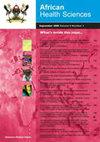脐内催产素缩短剖宫产至胎盘娩出时间的初步疗效、可行性和安全性:一项探索性随机试验
IF 0.9
4区 医学
Q3 MEDICINE, GENERAL & INTERNAL
引用次数: 0
摘要
背景:阴道分娩或剖宫产后胎盘分离延迟是产后出血的重要原因,其他原因包括子宫张力不全。脐内催产素已被证明可以缩短阴道分娩后到胎盘分娩的时间。然而,脐内催产素对减少剖宫产后至胎盘分娩时间的效果尚不清楚。 目的:探讨脐内催产素缩短剖宫产至胎盘娩出时间的初步疗效、可行性及安全性。方法:在南非东开普省的一家三级医院进行了一项双盲、安慰剂对照、探索性随机临床试验。共有66名选择剖宫产的妇女被纳入研究,随机分为催产素组(n = 33)和安慰剂组(n = 33),分别接受30ml生理盐水和20单位的催产素脐内输注。数据分析采用Epi Info和RevMan软件。通过检查从婴儿出生到胎盘完全娩出的时间来评估初步疗效;失血大于500毫升;需要人工摘除胎盘;以及胎盘的完整性。通过观察导管的成功插入和溶液的注入来确定其可行性。通过调查该过程的不良反应来评估安全性。 结果:安慰剂组有4名妇女(12%)出现胎盘分娩延迟,而催产素组只有1名(3%)。安慰剂组从出生到胎盘娩出的平均时间为159秒(SD 61),催产素组为143秒(SD 45)。两组间差异无统计学意义。通过在所有66例患者中成功插入导管和注射大部分溶液,证实了该方法的可行性。未发现该过程的不良反应。 结论:剖宫产术中应用脐内催产素是可行、安全的,有缩短胎盘娩出时间的潜力。涉及更大样本量的进一步研究是合理的。 关键词:剖宫产术;intra-umbilical催产素;产后出血。本文章由计算机程序翻译,如有差异,请以英文原文为准。
Preliminary efficacy, feasibility and safety of intra-umbilical oxytocin to reduce the time to placental delivery at caesarean section: an exploratory randomized trial
Background: Delayed placental separation either after vaginal birth or caesarean birth is an important cause of postpartum haemorrhage, among other causes such as uterine atony. Intra-umbilical oxytocin has been shown to reduce the time to placental delivery after vaginal birth. However, the efficacy of intra-umbilical oxytocin to reduce the time to placental delivery following caesarean section birth is not known.
Objectives: To explore the preliminary efficacy, feasibility and safety of intra-umbilical oxytocin to reduce the time to placental delivery at caesarean section.
Methods: A double-blind, placebo-controlled, exploratory randomized clinical trial was conducted at a tertiary hospital in the Eastern Cape Province, South Africa. A total of 66 women undergoing elective caesarean section were enrolled in the study and randomized into oxytocin group (n = 33) receiving an intra-umbilical infusion of 20 units of oxytocin in 30ml saline, and placebo group (n = 33) receiving an intra-umbilical infusion of 30ml saline. Data were analysed using Epi Info and RevMan software. Preliminary efficacy was assessed by examining the time elapsed from birth of the baby to complete delivery of the placenta; blood loss more than 500 ml; the need for manual removal of the placenta; and the completeness of the placenta. Feasibility was determined by observing the successful insertion of the catheter and injection of the solution. Safety was evaluated by investigating adverse effects of the procedure.
Results: Four women (12%) in the placebo group had a delayed placental delivery compared to one (3%) in the oxytocin group. The mean time from birth to placental delivery was 159 (SD 61) seconds in the placebo group and 143 (SD 45) seconds in the oxytocin group. There was no statistically significant difference between the two groups. Feasibility of the procedure was confirmed by successful insertion of the catheter and injection of the majority of the solution in all 66 cases. No adverse effects of the procedure were identified.
Conclusion: Administration of intra-umbilical oxytocin is feasible, safe and has potential to reduce the time of placental delivery at caesarean section. Further studies involving larger sample sizes are justified.
Keywords: Caesarean section; intra-umbilical oxytocin; postpartum haemorrhage.
求助全文
通过发布文献求助,成功后即可免费获取论文全文。
去求助
来源期刊

African Health Sciences
MEDICINE, GENERAL & INTERNAL-
CiteScore
2.30
自引率
0.00%
发文量
179
审稿时长
>12 weeks
期刊介绍:
The African Health Sciences is an internationally refereed journal publishing original articles on research, clinical practice, public health, policy, planning, implementation and evaluation, in the health and related sciences relevant to Africa and the tropics. Its objectives are to: Advocate for and promote the growth of reading culture in sub Saharan Africa; Provide a high quality journal in which health and policy and other researchers and practitioners in the region can and world wide, can publish their work; Promote relevant health system research and publication in the region including alternative means of health care financing, the burden of and solution of health problems in marginalized urban and rural communities amongst the displaced and others affected by conflict; Promote research and the systematic collection and collation and publication of data on diseases and conditions of equity and influence; Promote development of evidence-based policies and guidelines for clinical, public health and other practitioners. African Health Sciences acknowledges support provided by the African Health Journals Partnership Project that is funded by the US National Institutes of Health (through the National Library of Medicine and the Fogarty International Center) and facilitated by the Council of Science Editors.
 求助内容:
求助内容: 应助结果提醒方式:
应助结果提醒方式:


